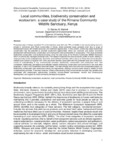Local communities, biodiversity conservation and ecotourism: acase study of the Kimana Community Wildlife Sanctuary, Kenya
Abstract
Protected areas in Kenya constitute 7% of the total land area with over 75% of wildlife in the country being found on private or communal land. Rural communities in Kenya, where protected areas generally exist, face a range of development issues with limited resources and livelihood opportunities. In this context, community-based biodiversity conservation has the potential to promote ecotourism opportunities which can reconcile and sustain economic development with biodiversity conservation and sharing the costs and benefits of conservation. This study examined biodiversity conservation and ecotourism issues using the case study of the Kimana Community Wildlife Sanctuary which is communally managed protected area. The research explored the socio-economic profile of locals residing in close proximity to the protected area. Economic and livelihood activities (with a focus on those that are ecotourism-related) were looked at together with other perceived benefits associated with the protected area and ecotourism. Levels of understanding of key environmental concepts (biodiversity, conservation and ecotourism) were also considered. Additionally, perceptions and attitudes towards biodiversity conservation and ecotourism in the area were assessed. A total of 100 households were interviewed. The main findings were that there was considerable support for biodiversity conservation and ecotourism among the respondents, although concerns were raised in relation to both complementary activities. There was, however, limited understanding of key environmental concepts. Key benefits were associated with employment opportunities (including tourism-related businesses), service and infrastructural development, and support for local community development projects.

